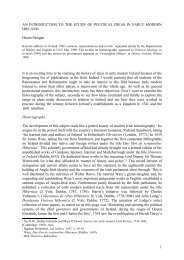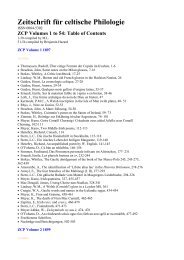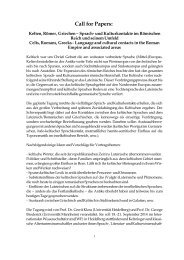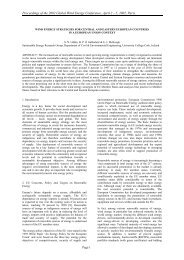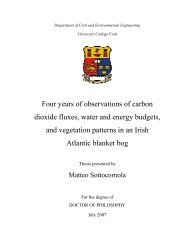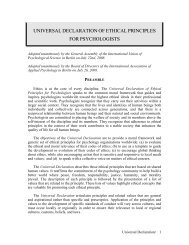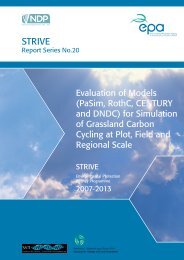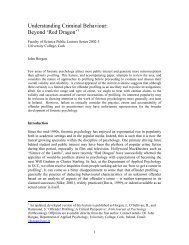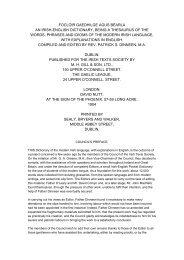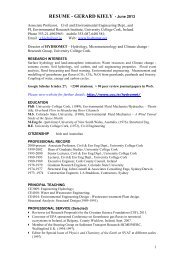2013 - University College Cork
2013 - University College Cork
2013 - University College Cork
You also want an ePaper? Increase the reach of your titles
YUMPU automatically turns print PDFs into web optimized ePapers that Google loves.
RESEARCH PROJECTS<br />
60<br />
Geosciences and Coastal Processes<br />
HOTSPOT ECOSYSTEM RESEARCH AND MAN’S<br />
IMPACT ON EUROPEAN SEAS (HERMIONE)<br />
Research Centre/Department/School:<br />
School of Biological, Earth & Environmental Sciences<br />
Contact PI: Andy Wheeler (a.wheeler@ucc.ie)<br />
Researchers: Boris Dorschel<br />
Start Year: 2009<br />
End Year: 2012<br />
Funding Body: EU FP7<br />
Funding: €70k<br />
Collaborating Partners: 38 partners including National<br />
<strong>University</strong> of Ireland, Galway & GeoZentrum Nordbayern<br />
Web: www.eu-hermione.net/<br />
Cold-water coral mounds of Lophelia pertusa are widespread across the Scandinavian shelf, which<br />
was completely ice-covered during the Last Glacial Maximum between 22 to 18 ka BP. Rapid<br />
deglacial meltdown of the Fennoscandian inland ice and the retreat of its ice-streams freed most<br />
of the shelf of ice by ˜15 ka BP. However, cold-water coral growth commenced only after the<br />
Pleistocene-Holocene transition at 11.65 ka BP, when modern-like climatic patterns and oceanographic<br />
conditions were established. A tight climatic coupling has been constrained with U-series<br />
ages. Coupled 14 C ages provide local reservoir ages from various gravity cores in a fjord-setting in<br />
Stjernsund at 70°N and on the open shelf in Trænadjupet at 66°N. Reinvestigation of earlier 14 C<br />
coral chronologies suggests that coral ecosystems widely established themselves across the entire<br />
3000 km long Scandinavian shelf prior to ˜10 ka BP. The earliest occurrence of Madrepora oculata<br />
at ˜2.4 ka BP suggests a late Holocene colonization of the Norwegian shelf, which is linked to a<br />
prominent mound growth hiatus in Trænadjupet (64°N). Mound growth rates near the northern<br />
biogeographic boundary of L. pertusa with up to ˜614 cm ka -1 during certain growth periods are<br />
much higher than the previously reported fastest rates of ˜220 cm ka -1 from the Irish margin. Contemporaneous<br />
rapid fjordbasin sedimentation is slower with ˜63 cm ka -1 . Matrix 14 C ages overlap<br />
with coral 14 C ages from the same horizon. This indicates rapid framework construction and efficient<br />
trapping of background sediment. Hiatuses are frequent in on-mound sediments and only<br />
short periods of coral growth are recorded. Coupled Δ 14 C and εNd values indicate a persistent<br />
Holocene inflow of the North Atlantic Current in Stjernsund, but also deglacial meltwater mixing<br />
during the early Holocene prior to ˜9.5 ka BP. Reservoir ages are overall close to the surface marine<br />
reservoir age, but ΔR is highly localized (Lopez Correa et al., 2012).<br />
KEY PUBLICATIONS & OUTPUTS<br />
Lopez Correa, M., Montagna, P., Joseph, N., Ruggesberg, A., Fietzke, J., Flogel, S., Dorschel, B., Goldstein, S.L.,<br />
Wheeler, A., Freiwald, A. (2012). Preboreal onset of cold-water coral growth beyond the Arctic Circle revealed by<br />
coupled radiocarbon and U-series dating and neodymium isotopes. Quaternary Science Reviews, 34, 24-43.



